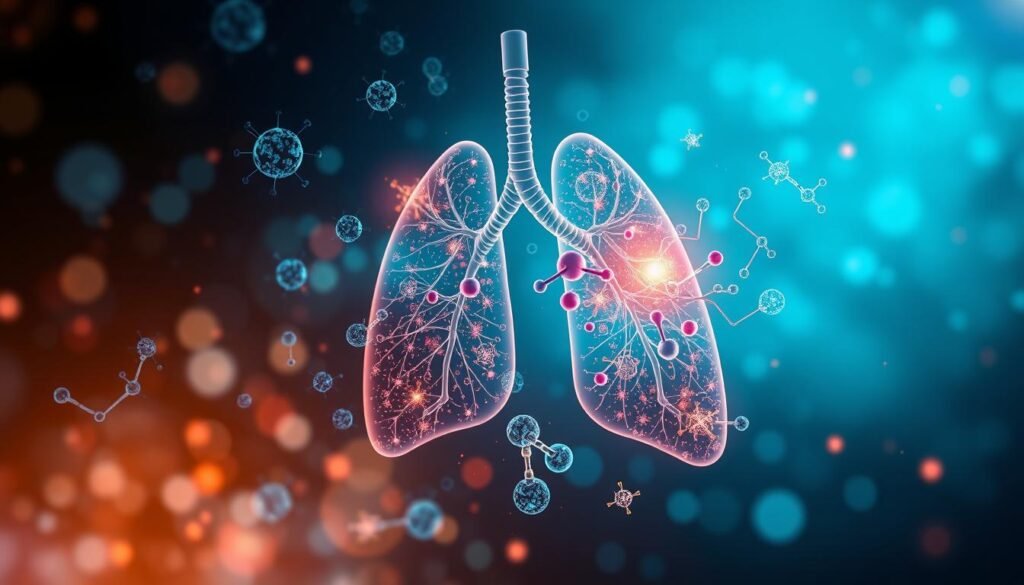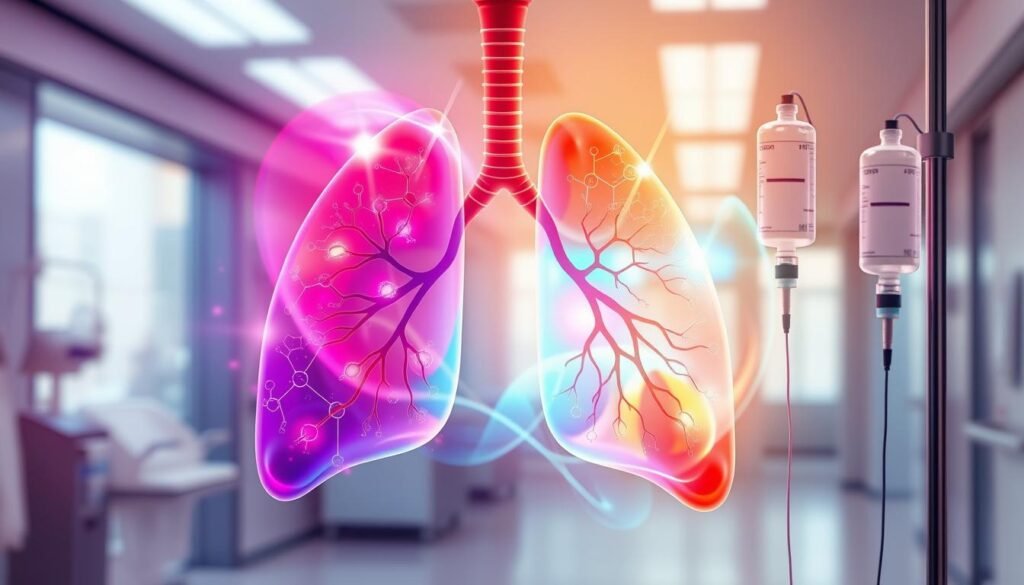Did you know that patients diagnosed with stage 4 lung cancer often face life expectancies of just 6 to 12 months? This fact highlights the urgent need for effective treatments. As the cancer advances to this stage, it usually spreads to other parts of the body. This creates major challenges for patients and their families looking for treatment options.
This guide focuses on the best treatments for stage 4 lung cancer. It offers insights into therapies and management strategies. It explains how these treatments work to relieve symptoms and slow down the disease. For patients and caregivers, making informed decisions is crucial. It’s important to look into all the treatments available for this tough diagnosis. For more info on life expectancy and survival rates, check this survival guide.
Key Takeaways
- Understanding stage 4 lung cancer is essential for proper management.
- Survival rates can change a lot based on treatments and health.
- Palliative care is all about making life better for patients.
- Options today include chemo, targeted therapies, and immunotherapy.
- Clinical trials could provide new and better treatments.
Understanding Stage 4 Lung Cancer
Stage 4 lung cancer is also known as metastatic lung cancer. It shows that the cancer has spread from the lungs to other body parts. This can include the liver, brain, or bones. It’s key for patients and doctors to know the cancer stage. It helps guide treatment options and estimate outcomes.
The stage has two parts: 4A and 4B. Stage 4A means there’s limited spread. Stage 4B indicates a wider spread of the cancer. This classification helps in coming up with specific treatment plans.
There are many treatments available for stage 4 lung cancer. Doctors often suggest more than one therapy. Treatments like chemotherapy might use drugs such as cisplatin or carboplatin with gemcitabine. There’s also targeted therapy. This can include sotorasib, or a mix of dabrafenib and trametinib for certain genes in non-small cell lung cancer.
For more details on treatments, click here. Options range from immunotherapy to radiation. Each aims to tackle stage 4 lung cancer in its own way.
In summary, stage 4 lung cancer is complex. But knowing about the disease stage can help patients choose the best care path. With the right strategies, patients can see an improvement in life quality and even extend their lives.
Identifying Symptoms of Advanced Lung Cancer
Knowing the signs of stage 4 lung cancer is key for fast diagnosis and getting treatment. This stage brings tough symptoms that really affect daily life. Spotting these signs early helps get the right medical help.
Common Symptoms of Stage 4 Lung Cancer
People facing the last phase of lung cancer report common symptoms, which include:
- Persistent cough that may lead to coughing up blood.
- Shortness of breath due to fluid around the lungs or tumor blockage.
- Chest pain, either from the cancer or side effects of treatments.
- Fatigue and major weight loss, linked to cancer-related conditions.
- Frequent respiratory infections from weaker lung function.
Symptoms Related to Metastasis
As lung cancer worsens and spreads, new symptoms can show up. These signs can mean the cancer has moved to places like the brain:
- Neurological symptoms like headaches, seizures, and feeling weak are signs of brain spread.
- Treating large airway blocks and bleeding with radiation.
- Managing pain with meds and radiation therapy.
- Seeing changes in skin temperature, mottling, less hunger, confusion, and different breathing patterns are end-of-life signs.
Understanding these advanced lung cancer symptoms is important for caregivers and doctors. This knowledge can lead to better care and support. Catching these symptoms early is crucial for treatment decisions and improving life quality.
Types of Lung Cancer: NSCLC vs. SCLC
Lung cancer consists of two main types: non-small cell lung cancer (NSCLC) and small cell lung cancer (SCLC). It’s important to know the differences. This knowledge helps in understanding how they differ in traits and treatment methods.
Overview of Non-Small Cell Lung Cancer (NSCLC)
Non-small cell lung cancer is the most common type, making up about 85% of cases. It includes subtypes like adenocarcinoma, squamous cell carcinoma, and large cell carcinoma. Each has its own behavior and treatment needs. This affects the patient’s outcome.
The five-year survival rate for NSCLC varies greatly by stage. Early-stage cases have survival rates as high as 64%. Advanced stages drop to around 8%.
Overview of Small Cell Lung Cancer (SCLC)
Small cell lung cancer accounts for 15% of all lung cancer cases. It’s mostly connected to smoking. SCLC grows quickly and is often found at an advanced stage. Its five-year survival rate is under 5%, showing the need for quick action.
Differences in Treatment Approaches
The way we treat lung cancer changes a lot between NSCLC and SCLC. NSCLC might be treated with surgery, targeted therapy, or immunotherapy. SCLC often needs chemotherapy and radiation because it spreads fast. Knowing these treatment options helps doctors manage the disease better and improve patient results.
| Type of Lung Cancer | Percentage of Cases | Common Treatments | 5-Year Survival Rate |
|---|---|---|---|
| Non-Small Cell Lung Cancer (NSCLC) | 85% | Surgery, Targeted therapy, Immunotherapy | 64% (early stage) – 8% (advanced stage) |
| Small Cell Lung Cancer (SCLC) | 15% | Chemotherapy, Radiation therapy | Below 5% |
The Importance of Personalized Treatment Plans
In treating lung cancer, personalized plans greatly improve patient results. Each cancer case differs, needing unique approaches tailored to the patient. With a deep understanding of lung cancer nuances, medical teams can craft strategies that fit individual patient circumstances perfectly.
Factors Influencing Treatment Choices
Several things affect lung cancer treatment choices. These include:
- Cancer type and stage: The difference between non-small cell lung cancer (NSCLC) and small cell lung cancer (SCLC) steers treatment.
- Genetic markers: Certain mutations, like the KRAS G12C mutation, help in choosing effective drugs.
- Overall health: A patient’s overall health and other health conditions influence the treatment plan.
At places like Memorial Sloan Kettering Cancer Center (MSK), detailed genetic tests help in making personalized treatment plans. The use of factors that influence treatment in planning means each patient gets care that’s right for them.
Role of Patient Preferences in Treatment Decisions
Patient wishes play a big role in planning treatments. It’s important to talk about what quality of life means to them and the side effects they might face. People often consider their experiences and values when choosing treatments. This kind of talk helps patients be part of their care plan.
By working together, doctors and patients make treatments more relevant and effective. Mixing treatment goals with what matters to the patient leads to better lung cancer care results. This approach ensures treatments truly meet individual needs.

Best Treatment for Lung Cancer Stage 4
Treating stage 4 lung cancer needs a well-rounded approach. The main goals are to lengthen survival and improve life quality for those affected. To find the best treatment for stage 4 lung cancer, doctors look at the cancer type, genetic changes, and what the patient prefers.
Overview of Treatment Objectives
The main aims of treating stage 4 lung cancer are:
- Improving Survival Rates: Non-small cell lung cancer has a five-year survival rate of about 9%. Small cell lung cancer’s rate is 3%. It’s crucial to focus on effective treatments.
- Easing Symptoms: Alleviating pain and other issues like malignant pleural effusion helps make patients more comfortable.
- Maintaining Quality of Life: Palliative care is key to this goal. It can extend life by three months if started early.
Current Treatment Options Available
There are many ways to manage stage 4 lung cancer now:
| Treatment Type | Description | Typical Usage |
|---|---|---|
| Chemotherapy | Uses two drugs together, often cisplatin or carboplatin, given in cycles. | Used when cancer grows after other treatments or with immunotherapy. |
| Targeted Therapy | Targets specific genetic changes, like osimertinib for EGFR mutations. | Chosen when tests find specific genetic markers. |
| Immunotherapy | Boosts the immune system to fight cancer, often using checkpoint inhibitors. | Suggested for those without mutations for targeted therapy. |
| Palliative Care | Focuses on symptom relief and improving overall well-being during treatment. | Started right after diagnosis. |
| Clinical Trials | Tests new treatments to find better ways to fight cancer. | Crucial for improving treatment methods and offering access to new options. |
Targeted Therapy for Lung Cancer
Targeted therapy marks a breakthrough in treating cancer. It zeroes in on the unique changes in tumors. This method is especially good for tackling lung cancer, like the common type called non-small cell lung cancer (NSCLC). By aiming at specific genes and proteins, these treatments stop cancer cells from growing and spreading. This offers a customized treatment plan.
What is Targeted Therapy?
Targeted therapy for lung cancer uses drugs that attack certain cancer cell changes. This means less harm to healthy cells. Each treatment is chosen based on the patient’s unique genes, found through tests like next-generation sequencing (NGS). Commonly targeted genes include EGFR, ALK, KRAS, and BRAF. The choice of therapy depends on these mutations.
Benefits of Targeted Therapy in Stage 4 Treatments
The advantages of targeted therapy at stage 4 lung cancer are clear:
- Improved Efficacy: These therapies work better at stopping tumor growth than standard chemotherapy, especially in tumors with certain mutations.
- Reduced Side Effects: Side effects are often fewer and easier to handle than those from older treatments. This means patients can enjoy a better life.
- Personalized Approach: Since the therapy focuses on specific genetic changes, the treatment is highly personalized. This greatly increases the chances of success.
| Gene Mutation | Common Treatments | Notes |
|---|---|---|
| EGFR | Afatinib, Erlotinib, Osimertinib | Effective for EGFR positive NSCLCs. |
| ALK | Crizotinib, Alectinib, Brigatinib | Targets mutations typically found in non-smokers. |
| KRAS G12C | Sotorasib | A newer targeted therapy option. |
| BRAF V600E | Dabrafenib, Trametinib | Used in combination for enhanced efficacy. |

Immunotherapy Options for Patients
Immunotherapy for lung cancer has changed the game.
It uses the body’s immune system to beat cancer cells. Many patients with advanced lung cancer look to it for a better survival chance.
Understanding Immunotherapy
Immunotherapy boosts the immune system to fight cancer.
It’s especially good for non-small cell lung cancer, the most common type. Treatments like pembrolizumab and nivolumab focus on the PD-1/PD-L1 pathway. They help immune cells attack tumors better.
Effectiveness of Immunotherapy in Advanced Lung Cancer
Studies show immunotherapy greatly helps advanced lung cancer patients. It leads to longer survival and tumor shrinkage.
Patients usually have fewer side effects than with traditional chemotherapy. Thanks to immunotherapy, lung cancer death rates are dropping. This success also encourages more clinical trials for new treatments.
| Immunotherapy Type | Mechanism | Approval Status |
|---|---|---|
| Checkpoint Inhibitors | Block proteins that prevent T-cells from attacking cancer | Approved for NSCLC (e.g., pembrolizumab) |
| Monoclonal Antibodies | Target specific antigens on cancer cells | Approved for various lung cancer subtypes |
| Combination Therapies | Utilize both immunotherapy and chemotherapy | Emerging data supports effectiveness |
Continuous research gives patients new immunotherapy options. This progress is making a big difference in treating advanced lung cancer.
Chemotherapy: A Key Component of Treatment
Chemotherapy is crucial in fighting stage 4 lung cancer. It attacks the fast-growing cancer cells to slow down tumors. The treatment is customized for each patient’s health and cancer stage.
How Chemotherapy Works
Chemotherapy stops cancer cells from multiplying. Drugs like Cisplatin and Carboplatin are often used. They’re given through an IV or sometimes as pills. Treatments happen in cycles of three to four weeks with breaks for recovery.
Side effects such as hair loss, nausea, and fatigue might occur because chemotherapy also affects healthy cells.
When is Chemotherapy Recommended?
Doctors suggest chemotherapy for advanced non-small cell lung cancer that has spread. It’s sometimes used before surgery to reduce tumors. Or, it can be given after to target any leftover cancer cells.
Healthy patients may also get chemotherapy with immunotherapy. This combination can work better together.

Radiation Therapy and Its Role in Management
Radiation therapy is key in treating lung cancer, mainly in patients with non-small cell lung cancer (NSCLC). It uses high-energy waves to kill cancer cells. Knowing the different types of radiation therapy helps patients and families make better treatment choices.
Types of Radiation Therapy Used
Several kinds of radiation therapy are used to fight lung cancer, including:
- External Beam Radiation Therapy (EBRT): This widespread method sends radiation from outside the body to the cancer.
- Brachytherapy: This technique involves placing tiny radioactive sources close to or inside the tumor to kill cancer cells directly.
- Proton Therapy: A unique method that uses protons instead of x-rays, reducing harm to nearby healthy tissues.
Indications for Radiation Treatment
Radiation therapy is used differently for lung cancer depending on the case, such as:
- It’s a main treatment if surgery isn’t possible due to tumor size or the patient’s health.
- It’s given after surgery to destroy any leftover cancer cells.
- It’s used before surgery to make tumors smaller and easier to remove.
- It helps relieve symptoms of metastatic disease like pain or trouble swallowing.
Palliative Care for Lung Cancer Patients
Palliative care is key in treating lung cancer, especially in advanced stages. It aims to improve life quality by managing symptoms and providing support. It tackles issues like pain, breathlessness, and psychological distress. Palliative care significantly helps those with lung cancer.
Focus of Palliative Care
The main goal of palliative care for lung cancer is symptom relief.
- Pain management
- Support for anxiety and depression
- Assistance with fatigue
- Improving breathing difficulties
It’s available at any illness stage, not just the end of life. Treatments may include surgery, medications, and oxygen therapy. It aims to improve daily life and overall experience.
Integrating Palliative Care with Other Treatments
Combining palliative care with regular lung cancer treatments boosts effectiveness and satisfaction. A team approach involves doctors, nurses, and social workers. They help manage symptoms and navigate treatment choices and side effects.
Palliative care is accessible in homes, clinics, and hospitals. Medicare and Medicaid might cover some treatments. To learn about palliative care’s impact, visit this study.
Palliative care is vital for lung cancer patients and their families. It helps understand treatments and prognosis. Starting palliative care discussions early enhances the treatment journey. For more on treatment options, see this resource.
Clinical Trials for Stage 4 Lung Cancer
Clinical trials for stage 4 lung cancer offer new treatment hopes. They test new drugs and methods to fight the disease. Joining these trials helps improve lung cancer care and offers access to cutting-edge treatments.
Importance of Clinical Trials
Clinical trials play a crucial role in cancer care. The Pragmatica-Lung trial, for example, plans to enroll 700 people. It will test new drug combos compared to usual chemotherapy. This trial includes a wide range of patients, making its findings more useful for everyone.
This approach helps doctors understand how treatments work in real life. It shows which therapies help people live longer and better.
How to Find Appropriate Clinical Trials
Finding the right clinical trial requires research and help. Patients and their families can use resources like the National Cancer Institute. They can also seek advice from doctors and cancer groups.
Local support groups offer personal advice and share trial information. This support can guide patients to trials that fit their needs. It helps them make informed choices about their care.
Complementary Therapies: A Holistic Approach
Complementary therapies include techniques to enhance well-being with lung cancer treatments. These methods help manage symptoms and improve life quality. They let individuals explore different care avenues, boosting physical and emotional health.
Types of Complementary Therapies
Many therapies are tailored for lung cancer patients. Notable ones are:
- Acupuncture: Relieves pain and nausea from traditional treatments.
- Yoga: Reduces stress and helps with mental clarity through gentle movements.
- Nutritional support: A healthy diet increases energy and strengthens the immune system.
- Meditation: Mindfulness brings emotional relief and lessens anxiety.
- Massage therapy: Promotes relaxation and releases body tension.
Combining these therapies benefits those on their lung cancer journey. Each therapy focuses on patients’ unique challenges.
Integrating Complementary Therapies into Treatment Plans
Adding complementary therapies to standard treatments offers more complete care. It’s key to talk to healthcare providers to avoid conflicts with traditional treatments. Patients should discuss complementary therapies with doctors for personalized advice.
Using resources like evidence-based articles aids in safely incorporating these therapies.
The aim is to better patients’ lives while ensuring treatments work together. Careful integration is necessary for safety and success, in line with treatment goals.
Conclusion
Fighting stage 4 lung cancer needs a well-thought-out plan. This plan should focus on the *best treatment for lung cancer stage 4*. Those with this late stage cancer face many challenges. They have several treatment choices, depending on their health and what they prefer.
Treatments like targeted therapy and immunotherapy are important. They can help patients live longer and improve their life quality. Adding in palliative care early on is also key. This care helps manage symptoms and support the patient and their family.
The way we treat advanced lung cancer is always getting better. New therapies, like EGFR tyrosine kinase inhibitors, are showing good results for some patients. Picking the right chemotherapy and starting palliative care early can really help with symptoms.
For some patients, chemotherapy using two drugs can be a good option. This is especially true if they’re strong enough for more intense treatment.
It’s crucial for patients and their families to talk openly with their doctors. This teamwork helps in handling the tough aspects of lung cancer care. By knowing the latest treatments and tailored care, patients can find the *best treatment for lung cancer stage 4*. This approach brings hope amidst a tough diagnosis.